In a world flooded with countless products and services, a strong brand identity is what sets a business apart. It’s more than just a logo or a catchy tagline — it’s the unique personality, values, and promise that a brand communicates to its audience.
Brand identity shapes how people perceive your business and determines how memorable and trustworthy you appear in their eyes. In today’s highly competitive market, building a clear and consistent brand identity is no longer optional — it’s essential for long-term success. Understanding the fundamentals of brand identity is the first step toward creating a powerful, authentic brand that resonates with your target audience.
What is the Brand Identity Prism?
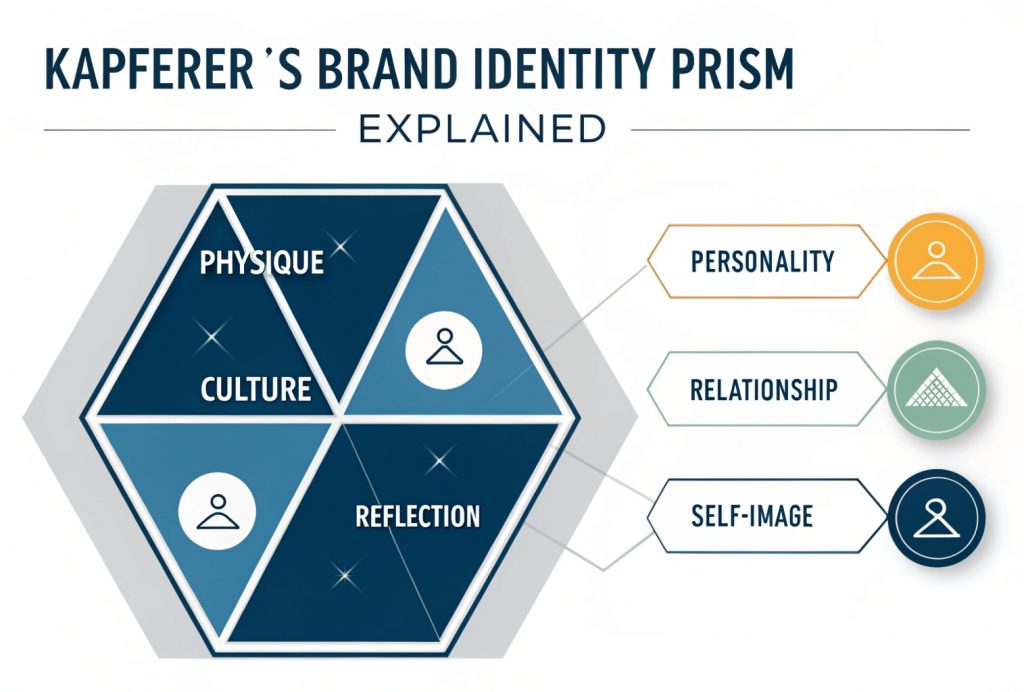
The Brand Identity Prism is a popular branding model developed by Jean-Noël Kapferer, a French marketing expert. He introduced this model to help businesses understand and define their brand in a more structured way. Instead of looking at a brand as just a logo or product, Kapferer believed a brand has a full personality and identity—just like a human being.
The prism is made up of six key elements that together form a complete picture of a brand. These elements help answer:
- What does the brand look and feel like?
- How does it talk?
- What values does it represent?
- How do customers see themselves when using the brand?
Kapferer’s model is powerful because it connects both the internal view of the brand (what the company wants to show) and the external view (how the audience actually sees it). This makes it easier for businesses to stay consistent in their messaging, visuals, and customer experience.
The Six Elements of Kapferer’s Brand Identity Prism
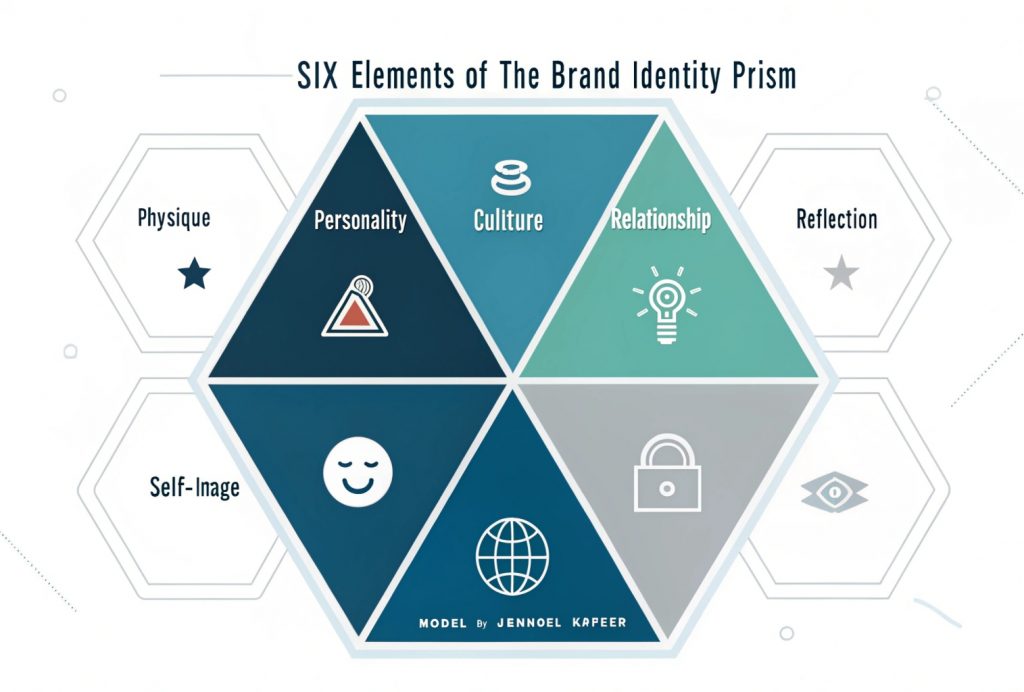
Jean-Noël Kapferer’s Brand Identity Prism is made up of six elements, each focusing on a different part of how a brand is built and perceived. These elements are grouped into two sides:
- External (what people see and feel from the outside)
- Internal (how the brand sees itself and what it stands for)
Let’s break them down one by one:
1 Physique – The Tangible Face of the Brand
This is the visual and physical side of your brand — the logo, packaging, colors, font, and product design. It’s what people first see when they interact with your brand.
Example: Apple’s sleek, minimalist product design is a key part of its physique.
2 Personality – Human Traits in Branding
This refers to the character and tone of your brand. If your brand were a person, how would it behave? Friendly? Bold? Professional?
Example: Amul has a witty and humorous personality through its topical ads.
3 Culture – Values and Principles Behind the Brand
Culture is about the beliefs, values, and mission that drive your brand. It comes from the company’s roots and influences how decisions are made.
Example: Patagonia promotes sustainability and eco-friendly practices as part of its brand culture.
4 Relationship – How the Brand Connects with Customers
This element focuses on the emotional connection between the brand and its audience. It includes the customer experience, tone of communication, and service behavior.
Example: Zappos is known for its customer-first approach and excellent support.
5 Reflection – The Brand’s Mirror of Its Audience
Reflection is how the brand sees its ideal customer or how it wants its customers to see themselves.
Example: Nike reflects people who are driven, athletic, and never give up.
6 Self-Image – How Consumers See Themselves with the Brand
This is about how people feel about themselves when they use your brand. It’s the internal view of the customer.
Example: Driving a Mercedes might make someone feel successful or high-status.
By understanding and defining all six elements, businesses can create a brand identity that is strong, consistent, and emotionally engaging.
Internal vs External Prism Elements
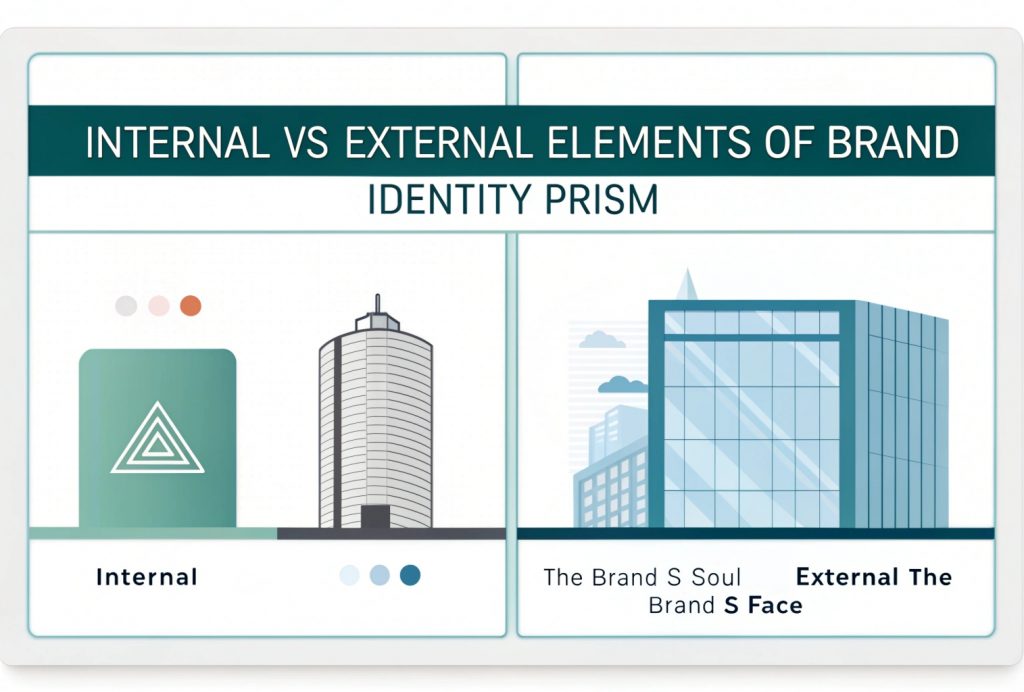
Kapferer’s Brand Identity Prism is smartly divided into internal and external elements. Understanding the difference between these two helps you create a brand that’s both authentic from the inside and attractive on the outside.
Differentiating Internal & External Aspects
- Internal Elements are what the brand believes about itself — its values, personality, and self-image.
These include:- Personality
- Culture
- Self-Image
- Personality
- External Elements are how the outside world sees and interacts with the brand — the look, feel, and connection.
These include:- Physique
- Relationship
- Reflection
- Physique
Think of it like this:
Internal elements represent the brand’s soul, while external elements represent its face.
How They Influence Perception
When internal and external elements work together smoothly, the brand feels genuine and consistent. But if they don’t align — for example, if a brand claims to care about sustainability (internal) but uses wasteful packaging (external) — people notice the mismatch.
By balancing both sides, brands can:
- Build trust with customers
- Create a strong emotional connection
- Stand out in a crowded market
In short, understanding both internal and external elements helps you present a brand that is true inside and out, making it easier for customers to believe in and connect with you.
Benefits of Using the Brand Identity Prism
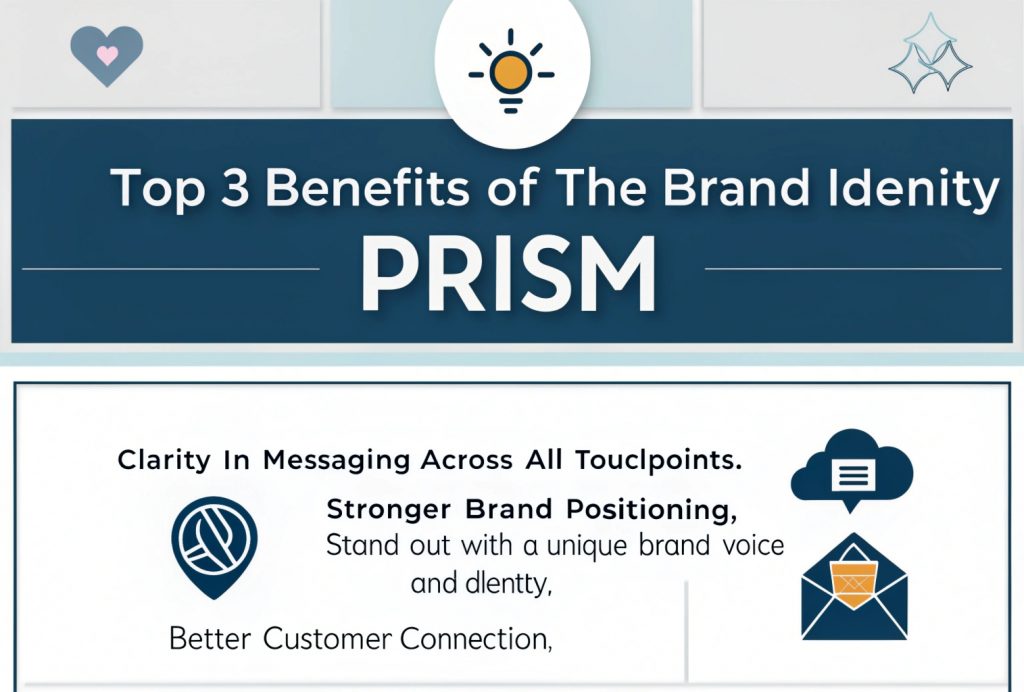
Using the Brand Identity Prism isn’t just about looking good on paper — it actually helps brands build clearer communication, stronger positioning, and deeper customer connections. Let’s look at how:
Clarity in Messaging
One of the biggest advantages of the prism is that it forces you to define every part of your brand — from how it looks to what it stands for. When all six elements are clear, it becomes much easier to create consistent messaging across ads, social media, packaging, and customer service.
Customers instantly understand who you are, what you offer, and why it matters.
Stronger Brand Positioning
With a well-defined identity, your brand stands out from the competition. The prism helps you carve a unique space in the market by aligning your brand’s look, voice, and values with what your audience cares about.
When your brand identity is strong and consistent, people remember you — and that gives you a big edge.
Better Customer Connection
The Brand Identity Prism also strengthens the emotional bond between your brand and your customers. When customers feel like your brand reflects their personality or values, they’re more likely to trust you, stay loyal, and even recommend you to others.
It’s not just about selling — it’s about building a relationship that lasts.
In short, the Brand Identity Prism helps brands become more focused, memorable, and relatable — all key ingredients for long-term success.
Explore our online programs to become future-ready
Transform your career with industry-aligned courses designed by experts.
Real-World Examples of Brand Identity Prism
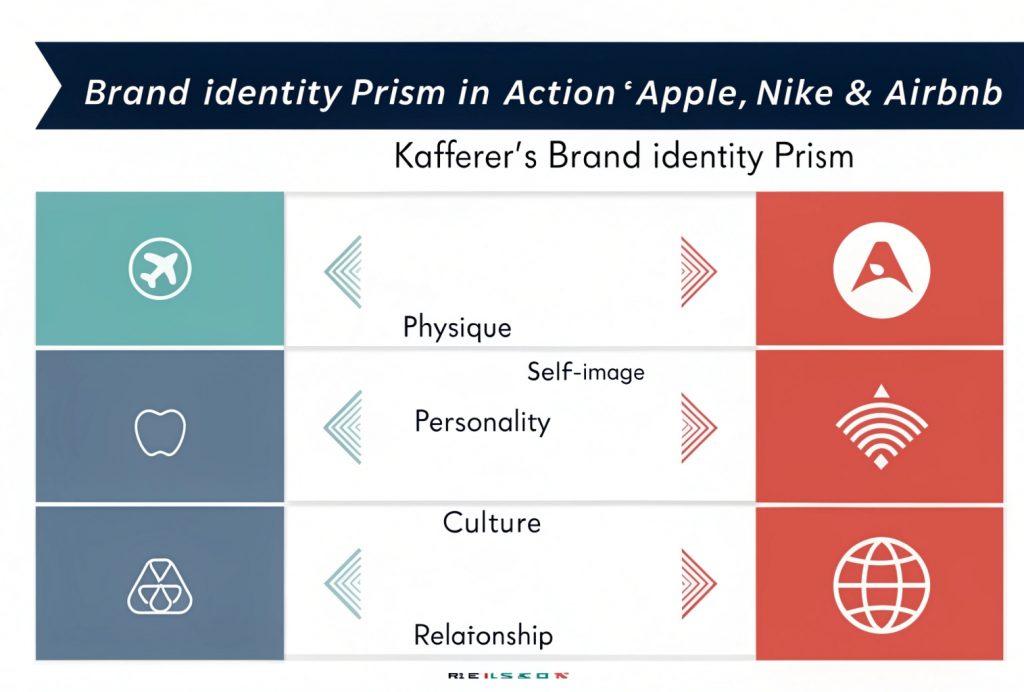
To really understand how the Brand Identity Prism works, it helps to see how some of the world’s biggest brands use it in action. Let’s break down three well-known companies — Apple, Nike, and Airbnb — using Kapferer’s six elements.
Apple
- Physique: Sleek design, minimalist packaging, clean logo, and cutting-edge technology.
- Personality: Innovative, premium, creative, and forward-thinking.
- Culture: Rooted in simplicity, innovation, and user-centered design.
- Relationship: A brand that empowers users to “Think Different” and explore their creativity.
- Reflection: Appeals to modern, tech-savvy individuals who value design and performance.
- Self-Image: Apple users often see themselves as creative, smart, and part of a premium, innovative lifestyle.
Nike
- Physique: Bold swoosh logo, athletic gear, powerful imagery of athletes in motion.
- Personality: Confident, motivational, driven, and energetic.
- Culture: Focused on athletic excellence, empowerment, and breaking limits.
- Relationship: Acts like a coach or motivator, constantly pushing users to “Just Do It.”
- Reflection: Represents people who are determined, passionate, and performance-driven.
- Self-Image: Nike users often see themselves as strong, ambitious, and always striving for success.
Airbnb
- Physique: Friendly logo, clean design, user-focused app and website.
- Personality: Warm, adventurous, inclusive, and welcoming.
- Culture: Built on trust, diversity, and the spirit of travel and belonging.
- Relationship: Acts as a travel guide and connector — making people feel at home anywhere in the world.
- Reflection: Appeals to open-minded, curious travelers who seek authentic experiences.
- Self-Image: Airbnb users see themselves as explorers, community-minded, and culturally aware.
These examples show how powerful the Brand Identity Prism can be in shaping a consistent and meaningful brand experience — one that customers recognize and connect with on a deeper level.
How to Build Your Brand Using the Identity Prism
The Brand Identity Prism isn’t just for big companies — it’s a useful tool for any business or personal brand. By following a simple process, you can build a strong and clear brand identity that connects with your audience and stands out in the market.
Step-by-Step Guide
Step 1: Define Your Physique
Start with the basics — your logo, color scheme, product design, and other visuals. Ask: What does my brand look like?
Make sure it’s simple, recognizable, and reflects your overall vibe.
Step 2: Shape Your Personality
Think of your brand like a person. Is it fun and playful, or serious and professional?
Choose a tone of voice and communication style that fits your values and audience.
Step 3: Clarify Your Culture
What does your brand stand for? List your core values, beliefs, and the “why” behind your business.
This helps build trust and long-term loyalty.
Step 4: Build the Relationship
How do you want to connect with your audience? Are you a helpful guide, a friend, or a leader?
Design customer experiences that match this role — in your content, service, and support.
Step 5: Understand Your Reflection
Describe your ideal customer. What kind of people do you want your brand to attract?
This helps you tailor your messaging and product offers to match their mindset.
Step 6: Define Self-Image
Ask: How do my customers feel about themselves when using my brand?
Make sure your brand makes them feel proud, smart, stylish — whatever fits your market.
Common Mistakes to Avoid
- Being inconsistent: Don’t change your tone, visuals, or message too often — it confuses people.
- Ignoring your audience: The prism must reflect both your brand and how your audience sees it.
- Copying others: Use inspiration, but don’t become a clone. Stay true to your own brand values.
- Skipping elements: Every part of the prism matters. Skipping even one can create gaps in your identity.
By carefully working through each part of the Brand Identity Prism, you’ll create a clear, authentic, and memorable brand that people understand — and more importantly, trust.
Conclusion
Building a strong brand goes far beyond just having a cool logo or catchy slogan. It’s about creating a complete identity that your audience can recognize, relate to, and trust. Kapferer’s Brand Identity Prism gives you a simple but powerful framework to define every part of your brand — from how it looks and sounds to what it stands for and how it connects with people.
By understanding and applying all six elements of the prism — Physique, Personality, Culture, Relationship, Reflection, and Self-Image — you can shape a brand that feels consistent, authentic, and emotionally engaging. Whether you’re just starting out or rebranding an existing business, this model helps you stay focused and build stronger connections with your audience.
In a crowded market, brands that are clear about who they are stand out. So take the time to map out your brand identity — and watch your brand grow into something truly meaningful.


Leave a Reply